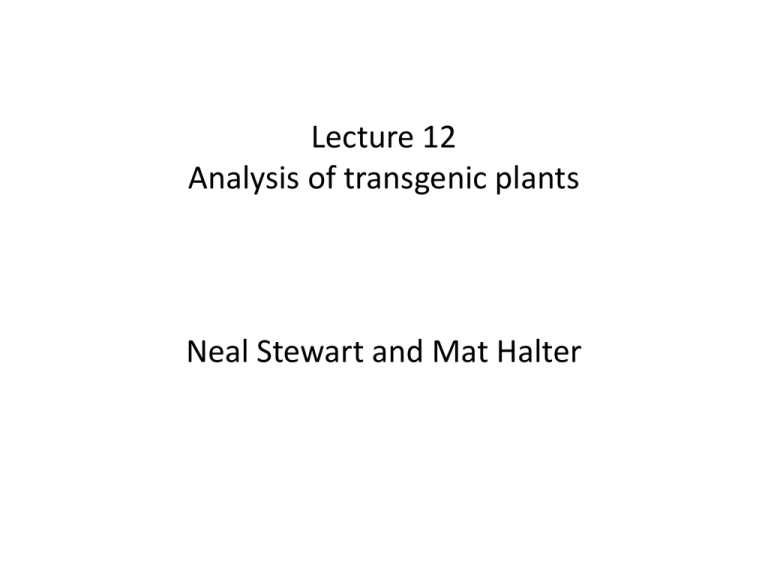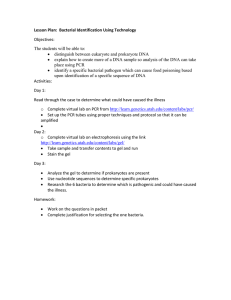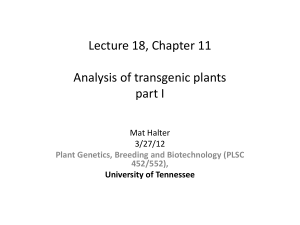Lecture 12 Analysis of Transgenic Plants
advertisement

Lecture 12 Analysis of transgenic plants Neal Stewart and Mat Halter Discussion questions 1. What are the established methods to determine if a plant is transgenic and whether the transgene(s) is expressed? 2. In a Southern or northern blot, through what type of chemical bond does the complementary probe bind to nucleic acid? 3. Nucleic acids and proteins are separated according to size in agarose and sodium dodecyl sulfate–polyacrylamide gel electrophoreisis (SDS-PAGE) gels, respectively. Why do both types of macromolecules migrate toward the anode in an electrical current? 4. What is gene expression, and how can you measure it? 5. Explain why phenotypic data provide evidence of transformation but not proof of a transformation event. 6. What factors are most important when designing a Southern blot experiment to test for transgenic status? Is my plant transgenic? Fig 12.1 LB P Visual Selection Visual Selection (OFP) T P Antibiotic Selection T P Gene of Interest T Antibiotic Selection (Hygromycin) Molecular methods for transgene insertion, copy number, and expression as well as Mendelian segregation of transgene in progeny RB Fluorescent Proteins http://en.wikipedia.org/wiki/File:FPbeachTsien.jpg Visual selection using FPs T+ T- T- T+ Antibiotic Selection • When a mixture of transformed and untransformed callus is placed on antibiotic selection media, only the transformed callus carrying the antibiotic selection cassette is able to survive and grow. • In most cases, the untransformed callus dies, making it “easy” to select for callus carrying the T-DNA. Sometimes “escapes” occur– for kanamycin resistance markers tissue is red—very stressed Is my plant transgenic? • Survives selection with antibiotics or herbicide—but remember that there can be escapes. Need more proof besides surviving selection. • Reporter genes—better. But there must be a reporter gene in the vector. What about false positives? • All around easy test—PCR. But what if Agrobacterium survives in low amounts in the T0 plants? Could give a false positive band. PCR is ok for biolistics. Why? • Can do PCR on T1 plants or look at segregation of the transgene. GFP+Bt segregation Using GFP screening to “see” Bt when the transgenes are linked. Nat Biotechnol 17:1125 Stable integration of transgene • Transgene is permanently integrated into the genome of the host plant. • Transmitted to progeny (Tn plants) in Mendelian fashion • Need convincing proof of stable integration • Multiple assays are possible—but most researchers are best convinced by Southern blot data. Why all the mystique and skepticism? Good reasons for doubt • New methods don’t always work, but wishful thinking takes over (see Chapter 11 section— the Rush to Publish) • Resilient Agrobacterium can linger • Others? Molecular characterization of transgenic plants • PCR- Simplest and fastest method. Prone to false positives. • Southern Blot- Confirms insertion of the T-DNA into the genomic DNA of the target organism, as well as provides insertion copy number. • Northern Blot- Confirms the presence of RNA transcript accumulation from the transgene of interest. • Western Blot- Confirms presence of the PROTEIN produced from the inserted transgene of interest. • qRT-PCR- Provides a relative expression level for the gene of interest—transcript—like Northern blot. PCR and DNA Gel Electrophoresis PCR- Polymerase chain reaction, uses DNA primers to amplify a target sequence of DNA, producing billions of copies of identical DNA. Gene cloning Molecular analysis (Confirmation of the presence of a particular fragment of DNA in a pool of DNA) - PCR analysis by gel electrophoresis = do PCR and run DNA on a gel - - + + + + Gel electrophoresis • The migration of DNA through an agarose matrix using the application of an electric field. • Agarose, when solidified in a gelatin form, produces a thick netting that allows small particles to move through it quickly, while larger particles move more slowly. • By moving particles of different size through the agarose gel, they can be separated, with the small particles moving quickly away from the slower moving large particles. • This method is used to separate DNA fragments by size. PCR analysis by gel electrophoresis - Ladder 1500 bp 1000 bp 750 bp 500 bp + Sample PCR and False Positives Transgenic plant produced from Agrobacterium-mediated transformation Genomic DNA • In T0 plants, Agrobacterium left over from the initial transformation is still present in all tissues. • Contamination of the genomic DNA with the initial transformation vector that is still present in the agrobacterium can produce a PCR band. Southern Blot • Southern blotting confirms the presence of the gene of interest in the genomic DNA of the target plant and avoids the pitfalls of potential false positives. • Steps – Genomic DNA isolation – Restriction enzyme digestion of genomic DNA – Running digested DNA on agarose gel to separate fragmented DNA by size. – Transfer of separated DNA to nylon membrane – Hybridization with radioactive DNA probe Restriction digest and gel electrophoresis http://www.ndpteachers.org/perit/Electrophoresis%20%5B2%5D.gif Restriction Digestion of Genomic DNA • Restriction digestion of genomic DNA produces a streak on an agarose gel rather than a single band. Why? Example: EcoRI • What is the probability of a sequence of DNA in a plant genome having the sequence of bases corresponding to an EcoRI cut site? • Each site can be 4 possible bases (A, T, C, or G), and the EcoRI enzyme requires 6 sites (GAATTC) • The probability of finding a random site in a genome that happens to have the sequence GAATTC can be calculated: 1⁄4 x 1⁄4 x 1⁄4 x 1⁄4 x 1⁄4 x 1⁄4 = 1⁄4096 • Probability states that there will be an EcoRI cut site once every 4096 bases, purely by chance. EcoRI example, cont. • The Arabidopsis thaliana genome is roughly 157,000,000 base pairs in size. 157,000,000⁄4096 = 38,330 • Though this value is only based on probability, and therefore may not be the TRUE number of EcoRI cut sites in this genome, it can still accurately be assumed that there are A LOT of cut sites. • If restriction digested with EcoRI, the Arabidopsis genome would be cut into tens of thousands of pieces, all of unique size. • This is why when you run a sample of digested genomic DNA, you see a streak, rather than a band. The streak shows all sizes of DNA produced by the random assortment of cut sites within the genome. Digested Genomic • Essentially, every known restriction enzyme will have cut sites in a plant genome. • How can enzyme selection be used to detect copies of an inserted transgene? EcoRI Site DNA Probe LB RB • Single cutting enzymes can be designed into the T-DNA before transformation that will enable proper digestion of the genome as well as a single cut within the TDNA. Figure 12.4 Southern Blotting Isolated genomic DNA from transgenic plant Gel electrophoresis Restriction enzyme digest - + Southern Blotting Transfer separated DNA from agarose gel to nylon membrane Agarose Gel Nylon Membrane Hybridizing the DNA probe • The DNA probe is designed to be complimentary to your gene of interest. •It is synthesized using radioactive phosphorus, which emits a detectable signal. •The complimentary probe will bind (by hydrogen bonding) only to your gene of interest because of the high sequence specificity. Southern Blotting Southern Blotting Lane 1- Ladder Lane 2- Negative Control Lanes 3-8- Experimental Events • Bands at different places from event to event indicate insertion at different places in the genome. • The number of bands in each well indicates how many insertions there were in each event. Final blot Why is a single cut within the T-DNA necessary? EcoRI Site EcoRI Site LB RB LB RB If there is no EcoRI site within the T-DNA, after digestion with EcoRI these two insertion sites will be indistinguishable from one another after electrophoresis and probing. Cutting within the T-DNA is necessary to distinguish each and every insertion event. This is VERY important. Restriction enzyme selection for Southern blotting BamHI EcoRI LB P Visual Selection EcoRI T BamHI P Antibiotic Selection T P EcoRI Gene of Interest Probe BamHI T RB Size (kb) 10 6 4 3 2 1.5 M WT 1 2 3 4 5 6 P Northern Blot • Confirms the presence of mRNA transcripts transcribed from the gene of interest in the target organism. • Extremely similar to the Southern blot, but detects RNA instead of DNA. • Steps: – – – – Isolation of RNA Running RNA on agarose gel to separate by size Transfer separated RNA from gel to membrane Hybridize a radioactive DNA probe to the RNA on the membrane Sound familiar? Northern Blot No digestion with RE is necessary… why is this? RNA loading controls are necessary to ensure an equal amount of RNA is loaded in each well. Western blot • Also to measure gene expression—at the protein level. • Extract proteins • Separate proteins on a vertical gel • Transfer to a membrane using an electrotransfer system • Probe with antibodies. • Stain for antibodies Western blots and ELISAs often use amplification of signal via antibodies http://probes.invitrogen.com/handbook/images/g001474.gif Figure 12.11 Western blot example What is missing in this experiment? For all blots (and all assays for that matter) • Use appropriate controls, such as a nontransgenic plant (negative) and a positive control typically plasmid for Southerns and specific for westerns. • Use an appropriate standard or a range of standards. • Set up the experiment intelligently ELISA—Enzyme-linked immunosorbant assay Real-life example • Can we engineer plants with a plant gene as a kanamycin resistance selectable marker? • An ABC (ATP-binding cassette) transporter from Arabidopsis • Used to produce transgenic tobacco • Compared against nptII gene • Both regulated by 35S promoters Mentewab and Stewart, 2005, Nature Biotechnology 23:1177-1180 How ABC WBC19 might work Are the plants transgenic for the ABC transporter? Digested with SacI and KpnI and probed with the ABC transporter DNA a. Segregation analysis of event 30 b. Northern blot analysis c. Root growth (trait) Event number 27 28 29 30 All T1 generation What can we infer about transgene expression of events 28 and 30? RT-PCR • Isolate RNA from tissues of interest • Eliminate all DNA from a sample • Make cDNA from mRNA— what is the result? • Perform PCR on sample using transgene-specific primers The figure is from an advertisement from a company—they are making the case that their RTPCR kit is better. What is the basis of their case? Real-time PCR or Quantitative PCR • Real-time PCR uses fluorescence as an output for DNA amplification in real-time. • The amount of starting template DNA (or cDNA for RNA measurement (real-time RTPCR) is correlated with the Ct number. • More DNA = lower Ct; Ct is the cycle number when a threshold amount of DNA is produced during the PCR experiment. http://www.rt-pcr.com/ http://www.youtube.com/watch?v=QVeVIM1yRMU Advantages of qRT-PCR over RT-PCR? Fig. 12.3 A B C Summary • Is my plant transgenic? – Survives selection – Reporter gene expression – Progeny analysis – PCR – Southern blot analysis • Is my plant expressing the transgene? – – – – – Northern blot analysis Western blot analysis ELISA RT-PCR Real-time RT PCR If you could choose just 3 of the above analyses, which ones would you choose and why?




